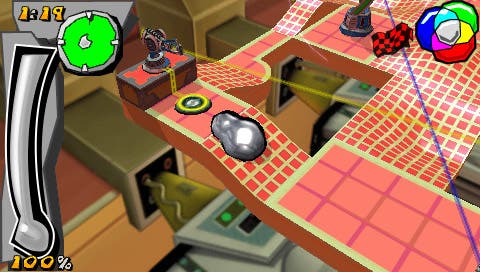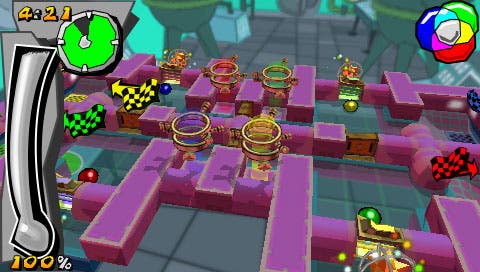Mercury Meltdown
Industrious.
Mercury is very bad for you. Not just very bad for you like alcohol, or dousing your crotch in oil and then dry-humping a fire, but mega-ultra-seriously bad for you. Even the American government, famously quite protective of things that cause massive amounts of harm (cf. guns, cigarettes, Tony Snow), declared in 1990 that mercury is a toxic pollutant that must be controlled to the greatest possible extent.
What they didn't do, and this was undoubtedly to Mercury-the-game's eventual detriment, was point out that whilst it must be controlled to the greatest possible extent, you also need to keep an eye on it. A rather beady, sharp, clear-sighted and sprightly one. And so when Mercury came out on PSP, even though the analogue control was almost perfect, the fact that it had a camera that often screwed you around and huge load times that sapped your concentration proved fatal.
Although I have no metaphor for the difficulty spikes - they were just bad.
Fortunately, on the evidence of our Mercury Meltdown preview build, much has changed for the better. As Ignition's Edward Bradley told us in our la-di-dah exclusive interview recently, the dev-team "didn't have the luxury of iterative design on the first one" - nor any final hardware to work on until it was almost too late. And that meant that things like the camera, the load times, the difficulty spikes, and redundant features like teleporters-which-are-the-same -as-suction-pipes simply had to be made done with.

In this regard, Meltdown's mercury has transitioned to a completely different state. The process of delivering your delicate blob of liquid metal from start to goal, running the gamut of endless obstacles, undulating surfaces and narrow ledges, rarely frustrates for reasons the developer didn't intend.
As well as quicker load-times, there are useful indicators, handy stabilisers and thoughtful options everywhere. A colour chart means that you can negotiate the levels that involve separating your mercury into smaller blobs, spray-painting them and then mixing colours without loading the Dulux website in the background; there's near-instant auto-saving after every level; you can change camera controls and even your mercury skin without exiting to some mother-menu; you can pause the game and roam around the level in free-look to get a feel for the challenges ahead; you can take on the 16 levels that make up the "lab" hub you're working through in any order, with more labs unlocked based on constituent progress rather than having to finish everything.
And for those who harbour rather unpleasant memories of Mercury's camera - even the second tutorial level began from a position where you couldn't see the blob - you'll be pleased to learn that the developer's promise to do away with level architecture that obscures your view has been mostly delivered upon.

Although most of the levels in our preview build (and even with less than half available, there are tons - it took me almost as long to get through them as it did to get to the end of the first game) focus on traditional elements - the challenge they pose is largely consistent with the first game's - there's a freshness to the gameplay that's invigorated by the improved design. It might be nice to have more than four camera angles to use, and it's worth noting that the vertical levels (usually a mix of platforms and travellators set against a steeply angled wall) don't really receive much help from the camera, but the free-look's very useful, and there are only a couple of minor examples that refute the claim about unhelpful level architecture.
More importantly, the way the game's been restructured appears to work in its favour. Last time out there were three types of goal: against-the-clock, puzzle and getting-to-the-end-with-all-your-mercury (they had better names though, obviously). Mercury Meltdown simply mixes things together; your efforts are rewarded in each area, but providing you do one thing satisfactorily you still complete the level successfully and bank a high-score. And then you can go back later and aim for perfection if you want - and based on my playing habits, you will want to.
One of the reasons for that is the wealth of unlockable content. Not just new labs - although there are eight of those in total and some secret levels too - but party games and new skins for your mercury. The former range from prosaic (race) to interesting (paint shop), and should give you something to do when you tire of the main game. You can also take people on at them wirelessly, and that multiplayer extends to tackling main-game levels with a pal too.

With only the early part of the game fleshed out fully, it's not really possible to get a total sense of the difficulty curve either - but in our experience it's usually possible to complete one goal even if you can't figure out the others to start with. The lure of high scores should prove interesting too - although in the absence of an Xbox Live style world leaderboards system for PSP, it'll be up to you how far you want to push it.
But with the design firmly weighted in the player's favour this time, the signs are good - and new elements, like rolling blocks to manoeuvre by obstructing their path, new types of mercury-targeting enemy and pads that affect the blob's viscosity, are likely to entertain players once they get past that initial thrill of fluid Mercury. The expansion of the level pool to 160 hasn't been a process of dilution by the look of it either - the quality stands up to the original game, with neat use of ice panels, speed pads, seesaws and other structures that force you to plot a course and apply some skill to navigate it. There are plenty of narrow ledges to hug, undulations to work against, colours to mix and multi-part blobs to worry about. Not to mention the usual array of difficult shortcuts to master.
This, really, was what attracted us to Mercury in the first place - and our Meltdown code throws up a good few. One, a vertical level that involves reaching turquoise spray-paint on the far side, can be cut short by deftly splitting the blob and then mixing more readily available colours - not something that you'll manage without a fair few spillages, and something that results in a big score when you master it.
If the full game can deliver more of that kind of thrill, and consistently avoids the pitfalls of the original, it could be essential.
Mercury Meltdown is due out on PSP this September.


